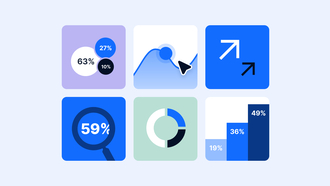Good SEO content is vital not only for the visibility of your website and attracting organic traffic, but for ranking higher in the search engine results pages (SERPs) too. It can help build audience trust, establish an organization’s authority in the marketplace, improve user experience, and — perhaps most importantly — increase on-site conversions.
SEO-optimized content can also contribute towards a better content experience for your site visitors, because your audience can find the answers or information they want more easily.
We know that creating content involves keeping a myriad of important factors in mind; with SEO-optimization being just one. So we’ve put together this guide with our 12 best tips for creating SEO content to help you concentrate on the most important parts of the practice to bear in mind.
Using a tool like Content Workflow by Bynder allows you to create bespoke templates where you can embed a list of pointers to guide your writers; whether they are in-house, agency, or freelance.
In this article, we’ve used a content item by Semrush to help you visualize the application of some of our tips.
1. Write for your readers first
For SEO content to do its job, it has to give readers the information they need in a way that’s easy to consume. It follows then, that you need to fully understand your readers’ intent so that you can create content that’s tailored in the right way.
It’s fine to use a target keyword (and variations of it) to help guide your content, but it should be done ‘naturally’.
It means that the ‘keyword stuffing’ approach should definitely be avoided. If your content reads like a robot wrote it, readers will be likely to click off the page more quickly. This can of course negatively impact your SERPs in the long term.
And it might require you to ‘go back to basics’ in that you invest time in writing an article on one subject rather than trying to cover multiple keywords in the same piece, but that’s ok.
2. Add keywords strategically in your SEO content
We mentioned the importance of using keywords naturally — and you should. But, if it’s appropriate to do so, aim to include them at least once in each of the following:
- In your H2 headings (or H3s)
- In the introduction
- Throughout the main body of content
- In the very last paragraph
Using keywords strategically helps search engines confirm the topic and depth of your content. This helps them to rank your content so that the people you want to find it can actually find it.
Semrush does this well in their content optimization guide:
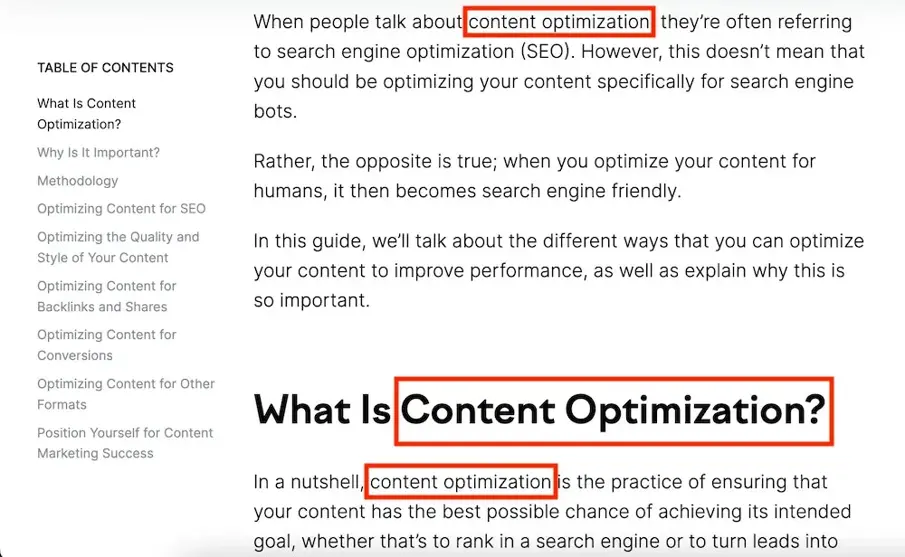
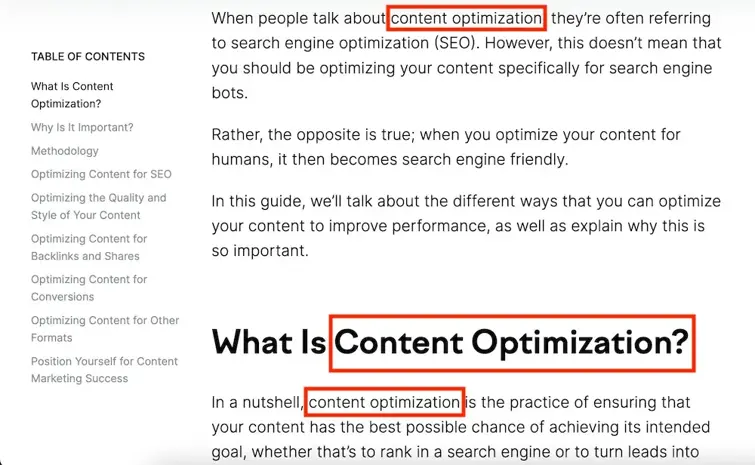
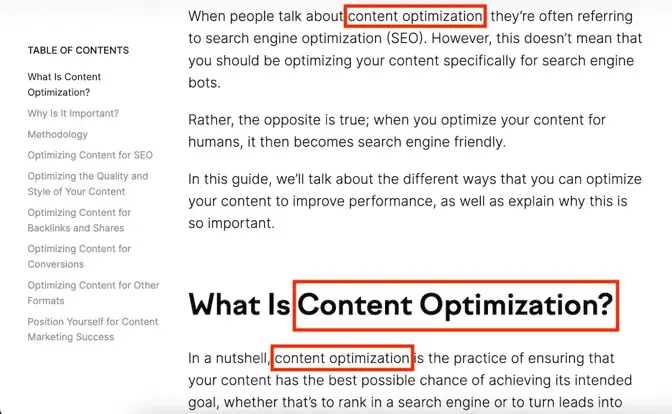
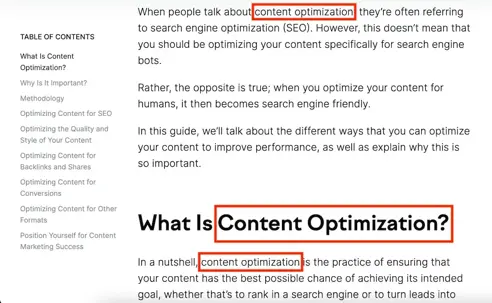
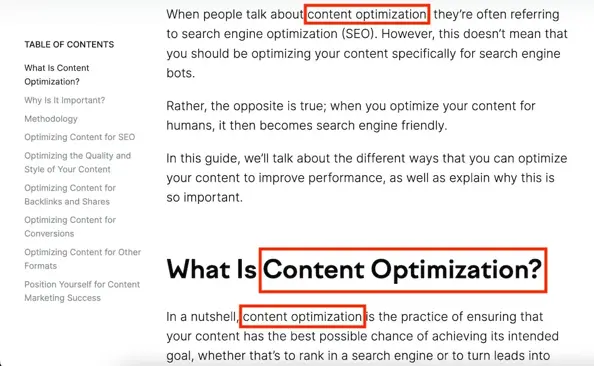 Semrush uses focus keywords strategically to help search engines understand the content
Semrush uses focus keywords strategically to help search engines understand the content
You can see the main keyword and a variation of it mentioned in the intro, in the first H2 heading, and within the main body of content. It’s mentioned elsewhere in the content too, but — crucially — it’s not overused.
3. Create content based on the questions readers have
The key to good SEO content writing is answering all the questions that your readers have on a given topic.
You can research what your readers are asking about when they conduct search queries by using a tool like Google’s People Also Ask. Use what you find to inform the content you create or update on your website; answering each search query thoroughly in your content.
For instance, here are a handful of questions people commonly ask about ‘content optimization’.
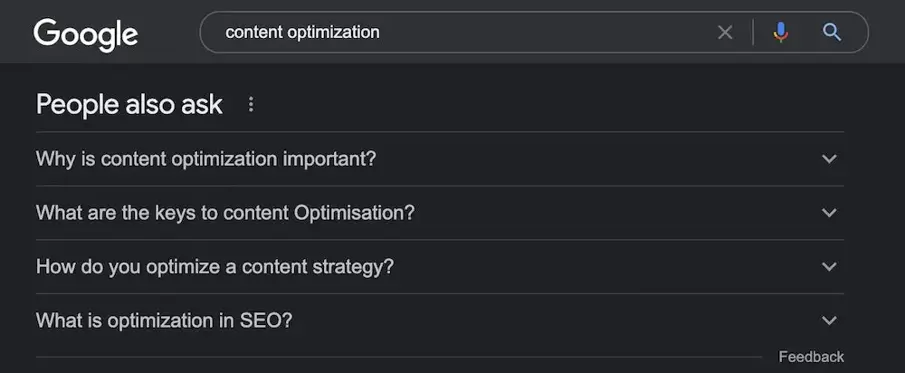
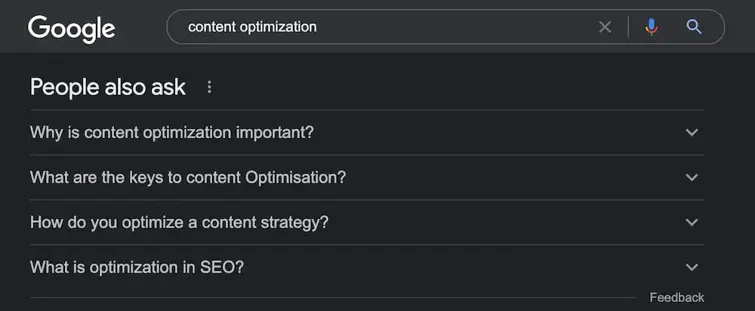
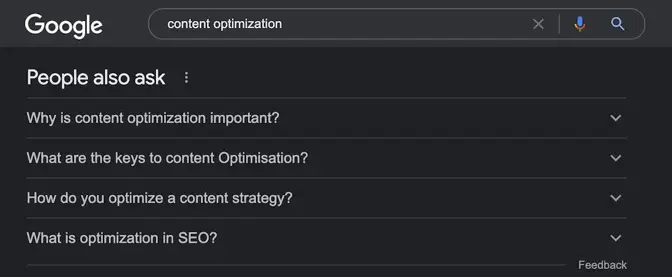
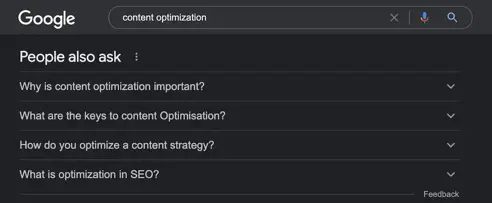
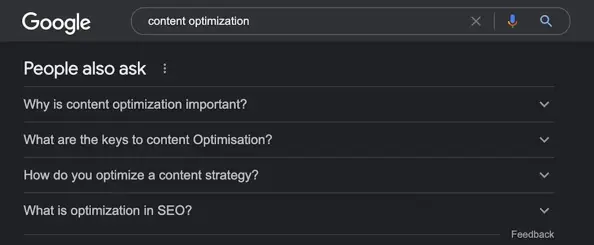 Google’s ‘People Also Ask’ section for the keyword ‘content optimization’
Google’s ‘People Also Ask’ section for the keyword ‘content optimization’
Now, let's look at the ‘Table of Contents’ from Semrush’s content optimization guide:
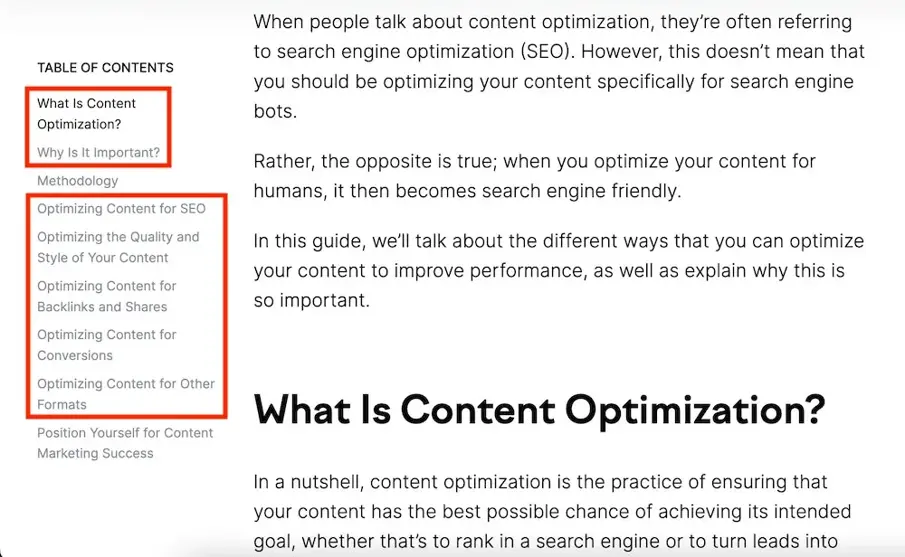
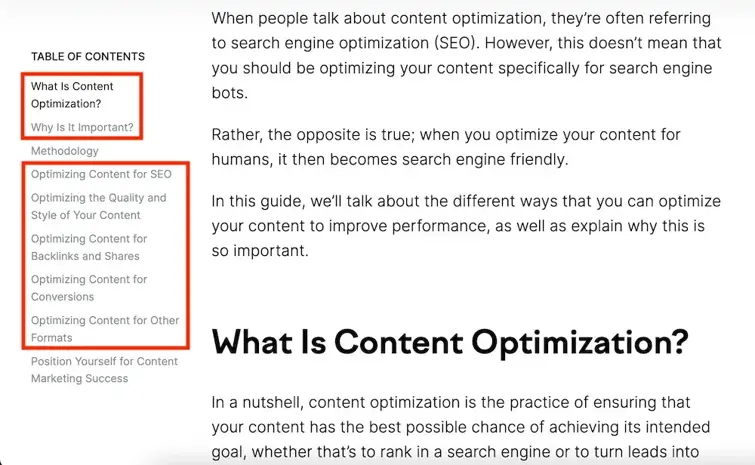
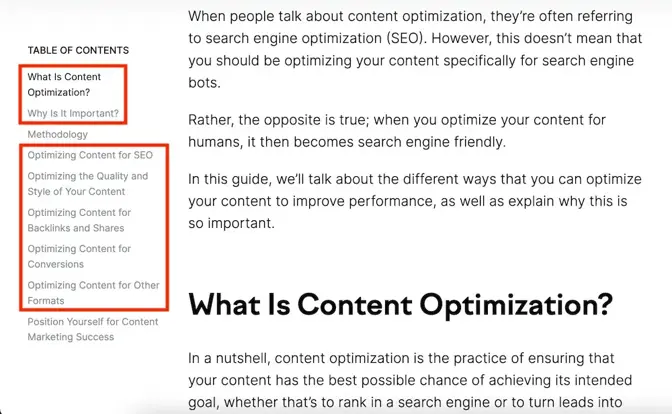
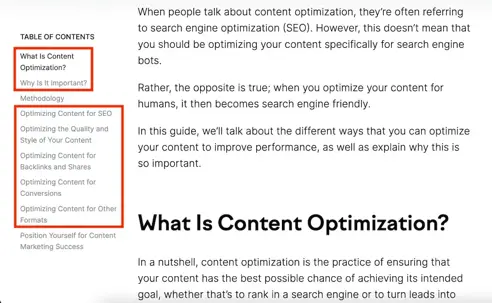
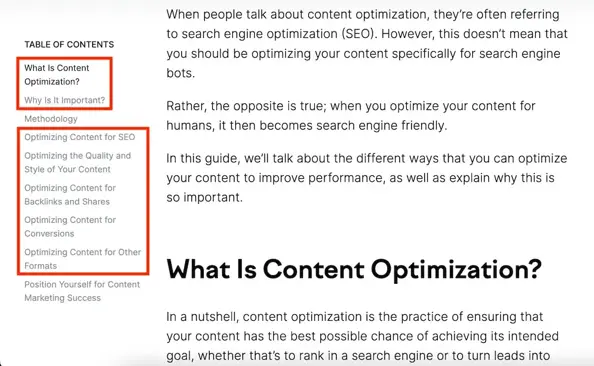 Semrush answers its audience's most commonly asked questions on the topic of content optimization.
Semrush answers its audience's most commonly asked questions on the topic of content optimization.
As you can see, it answers several questions from the People Also Ask results. This includes covering what content optimization is and why it matters as part of their guide, whilst the rest of their content dives into various other aspects of content optimization.
4. Structure content for readability
It’s essential to make it as easy for readers to navigate and understand your content as possible. You can do this by:
- Dividing content into clear sections with subheadings
- Organizing those sections in a logical order
- Using succinct paragraphs and sentences
- Utilizing bullet points when appropriate
- Formatting some words/sentences in bold to highlight key points
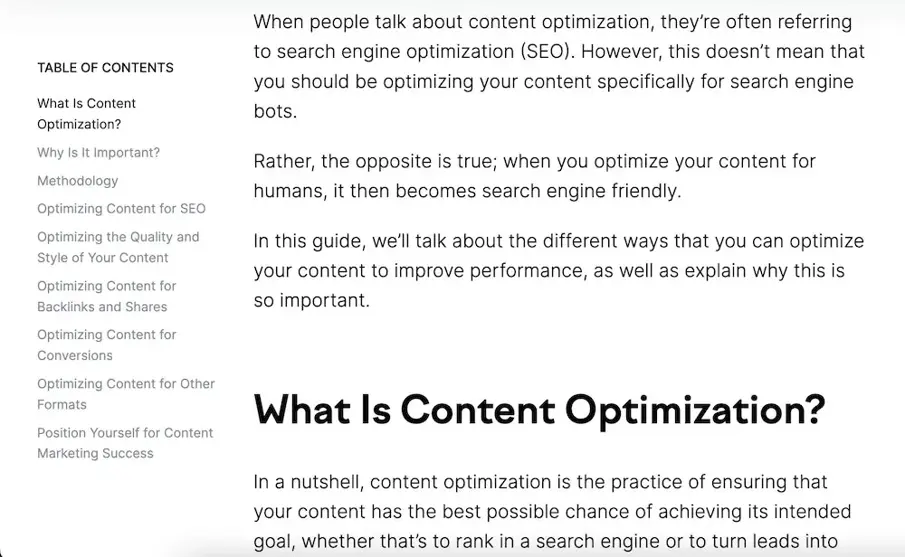
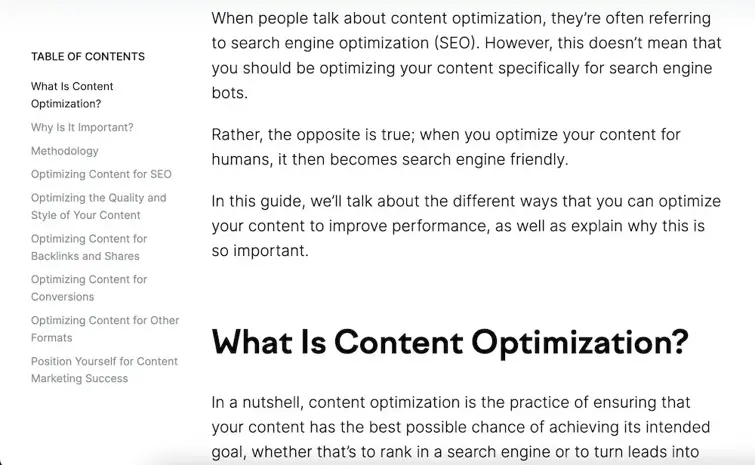
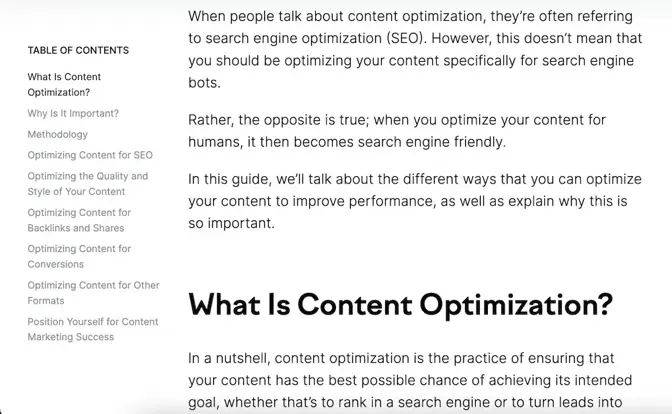
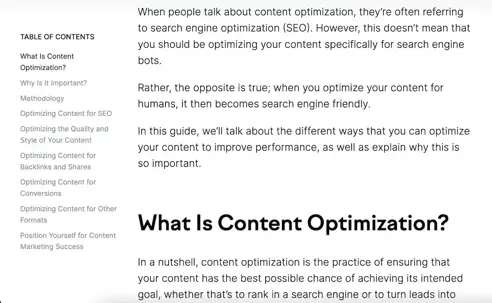
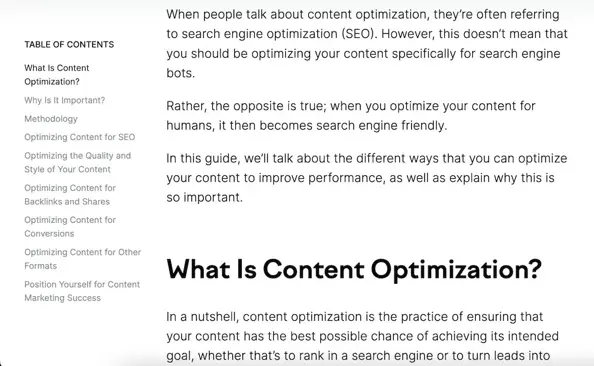 Semrush often uses short paragraphs and clear headings to aid readability
Semrush often uses short paragraphs and clear headings to aid readability
5. Write clear subheadings
Subheadings help visitors to see — at a glance — whether your content is likely to answer their questions. Overall, they also help improve a piece of content’s readability.
Plus, if you frontload main points within your paragraphs, they can help you snag featured snippets on Google.
6. Write keyword-enriched meta descriptions
Write relevant meta descriptions that give readers a reason to click to read your content from the search results.
- Mention what aspects of a topic your content covers and how the information is beneficial.
- Try to use verbs — for example, ‘learn’, ‘discover’, and ‘read’ — to encourage searchers to click through.
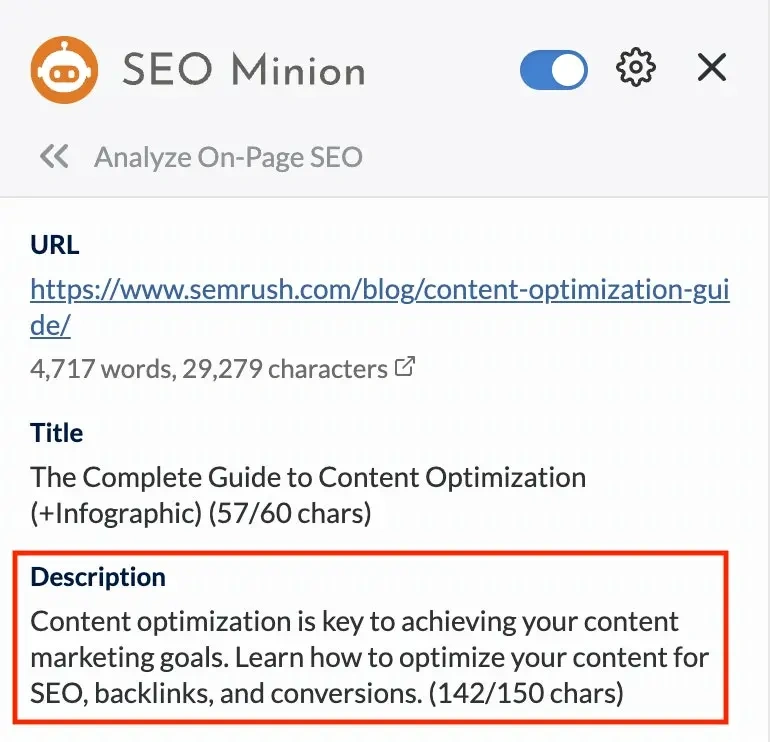 Semrush’s meta description frontloads the main keyword and uses a verb to encourage click-throughs
Semrush’s meta description frontloads the main keyword and uses a verb to encourage click-throughs
Include your focus keyword as close to the front of the meta description as possible, along with other relevant terms.




 Semrush uses the ‘content optimization’ keyword in the very first sentence of their guide.
Semrush uses the ‘content optimization’ keyword in the very first sentence of their guide.
7. Add alt text to all images
“Alt text provides better image context/descriptions to search engine crawlers, helping them to index and rank an image properly in image search.” (Definition taken from Moz.com)
These short descriptions are not only important for search engines, but they also make your web content more accessible to audience members who may have a visual impairment (and therefore may be using a screen reader or similar to help them understand the content they’re viewing online).
8. Make your page titles compelling
Be sure to include your target keyword in your page title tag. This will give search engines another cue as to what your content is about, helping them rank it more accurately in any search results.
It’s also important that your titles entice people to read your content. Answering what’s in it for them as part of your title can encourage more engagement.
For example, can you spot the ‘promise’ implied below in our Semrush example?
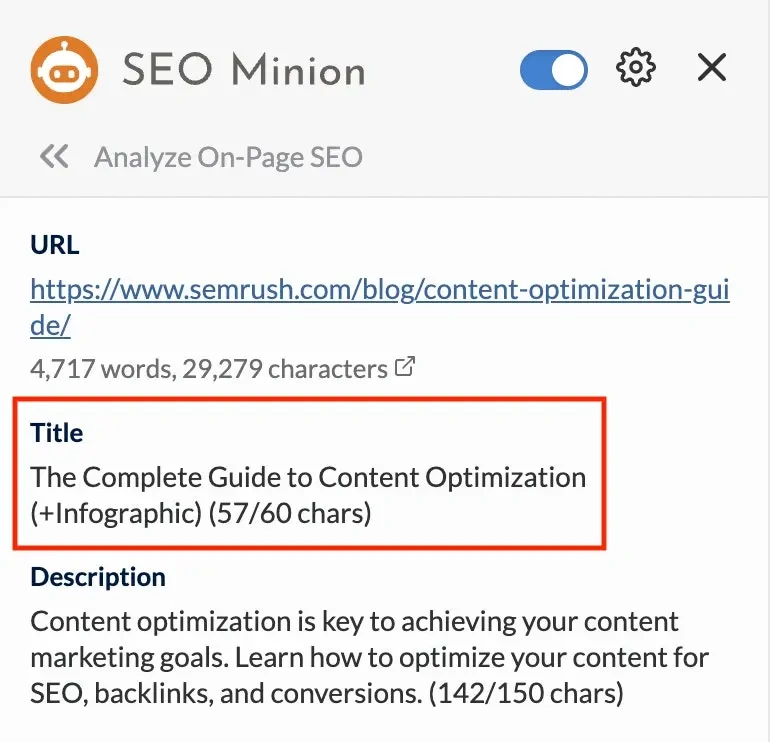 Semrush’s title uses the target keyword and sets clear expectations for readers
Semrush’s title uses the target keyword and sets clear expectations for readers
Its use of ‘Complete Guide’ indicates to the reader that the content will be in-depth and comprehensive — i.e. they will obtain everything they need from this one piece of content.
9. Use visual content
A large part of writing content for SEO involves using visual content. Why? Because images and other types of visual creative can help with readability and your rankings.
For instance, explanatory visuals such as infographics can further a reader’s understanding of a particular topic.
They also help to break up dense blocks of text and ultimately contribute towards keeping visitors on your site for longer.
Useful or interesting images, diagrams, or infographics can sometimes be picked up by other websites — and they may link back to your content as a reference related to content they’re producing.
What does this mean? Attracting quality backlinks that can provide a boost to your search engine rankings.
10. Keep your URLs short
Keep your URLs simple and as short as possible. So rather than using a whole title as your URL, use your focus keyword as the URL slug. Words like ‘the’ or ‘a’ are simply not necessary to include, so you can remove them.
You should also avoid using numbers in your URLs, as this can complicate things if you need to make future updates to your content (For example, ‘/content-optimization-guide-2022’).
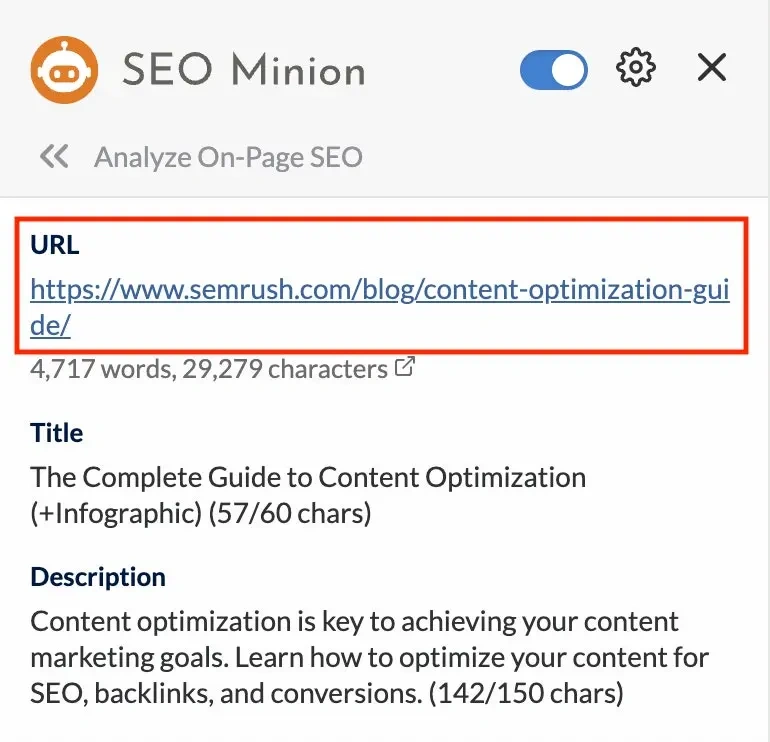 Semrush’s URL is short and simple — with the target keyword front and center
Semrush’s URL is short and simple — with the target keyword front and center
11. Add transcripts to your video content
If you produce video content, don’t forget to include an accurate transcript for each one as you upload them. Transcripts tell search engines like Google what’s being said in your video, and subsequently, this can help the content rank for relevant search queries.
12. Add internal links to your content
Signposting audiences to related pieces of content on your website by using internal links can benefit your SEO rankings in two main ways:
- It helps and educates your audience, giving them the info they need: It also keeps them on your website for a longer period by promoting further engagement.
- It shows search engines the extent to which you are covering particular topics. So, the more thoroughly you cover industry topics (via your high-quality SEO-optimized content), the more authoritative your website will seem to readers, and the more highly search engines may be willing to rank those pages.
Create SEO content that works
You now have the know-how to write content that has a good chance of ranking more highly; all that’s left is to put that knowledge into action — and to keep doing this consistently.
Speaking of consistency, a tool like Content Workflow by Bynder can greatly help by providing the framework for you to:
- Create your publishing schedule and manage your content calendar
- Be able to accurately brief in-house or freelance content writers
- Maintain your standards for SEO optimization thanks to Content Workflow’s flexible content template facility
These are just a few of the features loved by the 2,000+ businesses that already use our platform. And, with Content Workflow’s recently added AI capabilities, users can now harness the power of AI for their content creation too.
Want to see how easy it is to plan and manage SEO content in Content Workflow by Bynder? Try it for free for 14 days.











